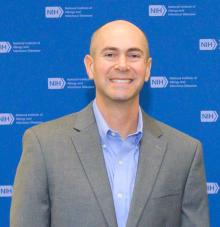Advancing Threat
Agnostic Biodefense
Webinar Series
Advancing Threat
Agnostic Biodefense
Webinar Series
The Advancing Threat Agnostic Biodefense Webinar Series brings together like-minded science and policy members of the biodefense community to discuss relevant research activities as well as barriers and enablers of a threat agnostic approach.
Threat-agnostic biodefense: Actions that are applicable to counter biological threats, reduce risks, and prepare for, respond to, and recover from biological incidents—whether the pathogens or toxins involved are known in advance or not.
Recordings of past webinars can be viewed on the YouTube playlist or via the links below.
A New Paradigm for Threat Agnostic Biodetection: Biological Intelligence (BIOINT)
December 10, 2024
Swati Sureka, Strategy and Policy Analyst, Arctic Slope Regional Corporation (ASRC) Federal

Just as remote imaging formed the basis for a new domain of geospatial intelligence (GEOINT) spanning military and civilian applications, we posit that agnostic sequencing of environmental nucleic acid samples should drive a paradigm shift in how we seek to understand our biological world. This new paradigm, which we call “biological intelligence,” builds on novel technologies and trends in biosurveillance, and differs from traditional approaches in critical ways.
Preparing for the Next Outbreak: Designing Closer Collaboration between Healthcare and Public Health to Deploy Pathogen-Agnostic Testing as an Early Warning System
November 13, 2024
Dr. Adi V. Gundlapalli, Senior Advisor, Centers for Disease Control and Prevention

The surveillance and identification of emerging, reemerging, and unknown infectious disease pathogens is essential to national public health preparedness and relies on fluidity, coordination, and interconnectivity between public and private pathogen surveillance systems and networks. Developing a national sentinel surveillance network with existing resources and infrastructure could increase efficiency, accelerate the identification of emerging public health threats, and support coordinated intervention strategies that reduce morbidity and mortality. This presentation will provide an overview of our recent efforts to understand the roles of clinicians, healthcare entities, clinical laboratories, and federal agencies in pathogen-agnostic metagenomic sequencing in the US.
Challenges and Opportunities in Pathogen Agnostic Sequencing for Public Health Surveillance
October 29, 2024
Drs. Matthew Kasper and Lindsay Morton, Department of Defense Global Emerging Infections Surveillance (GEIS) Program

In this talk, we will highlight opportunities and challenges for the implementation of pathogen agnostic sequencing in the context of the wider global community.
Pathogen agnostic sequencing is crucial for biodefense and public health, aiding in infectious disease detection and monitoring. The US government’s commitment is evident in the latest National Biodefense Strategy, American Pandemic Preparedness Plan, and 2023 Broad Agency Announcements from the Department of Health and Human Services, including the CDC and BARDA. Next-generation sequencing (NGS) technologies, which offer higher-throughput genome sequencing, have become more affordable and widely adopted in biomedical and public health labs. The reduced cost per genome or sample has made NGS a key part of routine public health surveillance.Exploring List-Based Approaches and Potential Threat Agnostic Applications in U.S. Biodefense and Public Health – Toward a Hybrid Approach
July 16, 2024
Dr. Yong-Bee Lim, Deputy Director of Converging Risks Lab, and Dr. Saskia Popescu, Professor at the University of Maryland
Following the COVID-19 pandemic and with the U.S. struggling to respond to a complex H5N1 outbreak, traditional approaches to preventing and responding to biological threats have underscored a need for a more agile and robust strategy. Evolving technical capabilities and lessons learned from recent outbreaks have provided us with an array of opportunities to strengthen bioresilience, but ultimately this requires a spectrum of tactics. In this presentation, Drs. Lim and Popescu discuss the current list-based approach to biodefense and public health within the U.S., but also explore an increasing need for threat-agnostic pathways for addressing the growing risk of outbreaks.
View the recording of "Exploring List-Based Approaches and Potential Threat Agnostic Applications in U.S. Biodefense and Public Health – Toward a Hybrid Approach."
Computational and Systems Biology Advances to Enable Bioagent Agnostic Signatures
June 18, 2024
Andy Lin, Computational Biologist, Pacific Northwest National Laboratory

Enumerated threat agent lists have long driven biodefense priorities. The global SARS-CoV-2 pandemic demonstrated the limitations of searching for known threat agents as compared to a more agnostic approach. Recent technological advances are enabling agent-agnostic biodefense, especially through the integration of multi-modal observations of host-pathogen interactions directed by a human immunological model. Although well-developed technical assays exist for many aspects of human-pathogen interaction, the analytic methods and pipelines to combine and holistically interpret the results of such assays are immature and require further investments to exploit new technologies. In this talk, we discuss potential immunologically based bioagent-agnostic approaches and the computational tool gaps the community should prioritize filling.
Toward Pathogen-Agnostic Detection: Advances and Challenges in Shotgun Sequencing-Based Biosurveillance
April 16, 2024
Patrick Chain, Scientist, Los Alamos National Laboratory

Patrick Chain leads the Metagenomics Applications, Bioinformatics, and Analytics Teams in the Bioscience Division at LANL, while also co-managing the Division's Genomics Program. His team pioneers innovative algorithms and methods in bioinformatics and metagenomics, applying them to various research areas such as organism detection, sample characterization, and fundamental research across different 'biomes'. With a background including a B.Sc. and M.Sc. from McMaster University and a Ph.D. from Michigan State University, Patrick Chain brings a wealth of expertise to the field.
View the recording of "Toward Pathogen-Agnostic Detection."
Assessing the Zoonotic Risk of Pre-emergent Viruses
February 20, 2024
Tony Goldberg, PhD, Professor, School of Veterinary Medicine, University of Wisconsin-Madison

Exploration of the “virosphere” is in its golden age. The sheer number of new viruses discovered daily, and the fact that most cannot be cultured, creates enormous about where to allocate attention and resources. It is not an intractable problem, however, to distinguish those few viruses that are likely to emerge as zoonoses from the many others that are not. This talk describes two diametric approaches to addressing this problem. The first approach involves a field-to-lab investigative methodology that, when combine with biologically informed predictive computational models, can assess the zoonotic risk of viruses that have not yet been identified in humans. The second approach relies on the power of modern methods in anthropology and ethnography to identify zoonotic transmission pathways, even before the identification of any pathogens that might traverse those pathways. A unifying example is simian hemorrhagic fever virus and its relatives in the family Arteriviridae, which cause important animal diseases but have never been documented to infect humans. Both approaches identify these viruses as high-risk pre-emergent zoonoses.
View the recording of "Assessing the Zoonotic Risk of Pre-emergent Viruses."
Ian Watson
January 23, 2024
Deputy Assistant Secretary of Defense for Chemical and Biological Defense (DASD(CBD))

Mr. Ian Watson currently serves as the Deputy Assistant Secretary of Defense for Chemical and Biological Defense (DASD/CBD). In this capacity he is the principal advisor to the Assistant Secretary of Defense (ASD) for Nuclear, Chemical, and Biological Defense Programs (NCB) and conducts Department-level research, development, and acquisition (RDA) activities from concept and requirements development, through early science and technology, to advanced development, testing and evaluation, and procurement. These efforts focus on reducing risk from emerging threats and fielding sustainable capabilities to all Services in accordance with Department, Service and Combatant Command priorities for chemical, biological, and ensure our warfighters can fight and win in chemical, biological, radiological, and nuclear (CBRN) contested environments.
Previously, Mr. Ian Watson served as the Deputy Assistant Secretary, and Director of the Office of Strategy, Policy, Planning, and Requirements (SPPR), and for Industrial Base Expansion in the Office of the Assistant Secretary for Preparedness and Response (ASPR) within the U.S. Department of Health and Human Services and as the Assistant Director for Biotechnology and Biosecurity within the Office of Science and Technology Policy (OSTP) in the Executive Office of the President (EOP).
View the recording of Ian Watson's presentation.
RNA? No way! Or, is it OK? Planetary Protection and the Interaction Potential for Fragments Returned to the Earth’s Biosphere from Asteroid or Cometary Material
January 16, 2024
Betsy Pugel, PhD, Planetary Protection Group Lead, NASA Goddard Space Flight Center

Spacefaring nations that investigate and return samples from planetary bodies comply with requirements that seek to preserve the microbial and organic integrity of that body when exploring there and that of our own Earth’s biosphere when returning samples. This is a part of the discipline known as Planetary Protection. When NASA returns samples from planetary bodies, those extraterrestrial samples can be subject to containment if the environment may support life as we currently know it. At present, Mars, a moon of Jupiter (Europa) and a moon of Saturn (Enceladus) are the planetary bodies that are subject to containment of samples when they return to Earth. The temperature, presence of water and levels of ionizing and non-ionizing radiation present may support that life and so, interaction potential between those extraterrestrial samples and Earth are reduced by taking containment or sterilization measures, known as Restricted Earth Return. Currently, much of our solar system, including our moon, Mercury, Venus, Jupiter, Saturn, Uranus, Neptune, and Pluto as well as asteroids and comets, are Unrestricted Earth Return missions, as the scientific consensus is that the lack of water, temperature extremes and radiation extremes make it unlikely for life as we know it to survive.
Is there evidence to start to ponder the re-evaluation of that threat from Unrestricted Earth Returns? Recent discoveries of uracil from asteroidal material raises the question of interaction potential between previously perceived non-threat materials from asteroids and comets with our biosphere. As there are common mechanisms for the generation of life on Earth in the Early Earth phases that are common to chemical interactions observed in samples returned from asteroids and comets, does that common chemistry hold any additional interaction threat when returned to Earth? At what level—base pairs? RNA? DNA? Microbial? How can risk be determined (interaction potential) for extraterrestrial RNA or DNA arriving to our local biosphere? What kinds of mitigations, if any, such as sample containment, need evaluation for future asteroidal or cometary missions?
Advances in Functional-Based Assays for Detection of Novel Pathogens
July 25, 2023
Zach Stromberg, PhD, Biomedical Scientist, Pacific Northwest National Laboratory

Functional assays exploit host-pathogen interactions as the basis of pathogen detection and often rely on detecting host responses during infection. Common pathogenic traits assessed may be produced by the pathogen itself (e.g., toxin production) and by the interaction of the pathogen with the host (e.g., cell death). Unlike conventional detection methods that target specific microbial sequences, functional assays are based on pathogen strategies used during the infection process. Platforms for high-throughput functional characterization have been elusive due to the challenge of creating an integrated system for pathogen extraction, interrogation, and assessment. Here, the development of an end-to-end pipeline for discovery of pathogenic features and detection of pathogens in real-world environmental samples will be discussed.
View the recording of "Advances in Functional-Based Assays for Detection of Novel Pathogens"
Intelligent Immunity - Drawing from Innate Immune Mechanisms to Design Pathogen-agnostic Diagnostics for Emerging Threats
June 15, 2023
Harshini Mukundan, PhD, Program Manager, Office of National Homeland Security (ONHS)

Harshini Mukundan is a program manager for chemical and biological technologies at ONHS, and also a scientist in the biosciences area. Harshini will cover the human innate immune system as a classical example of a pathogen agnostic diagnostic and therapeutic system. Mimicking innate immunity in the laboratory can allow for the universal identification of emerging threats, increasing our preparedness against future pandemics and biowarfare events. We have been working on understanding core principles guiding host-pathogen interactions and adapting them to design tailored assays for the direct detection of pathogen signatures in complex clinical samples. A snapshot of design to deployment of this approach - including preliminary clinical studies in blinded cohorts will be presented. Finally, we will touch on current work intended to expand the scale of this understanding to achieve a machine learning model of innate immunity that is truly agnostic.
Technologies Accelerating Infectious Disease Research: Highlights from the NIAID Systems Biology Program and Perspectives on Pathogen Detection Technologies
May 3, 2023
Reed Shabman, PhD, Program Officer, National Institute of Allergy and Infectious Diseases (NIAID)

Dr. Reed Shabman is a Program Officer in the Office of Genomics and Advanced Technologies at the NIAID and currently serves as the Program officer for the Systems Biology for Infectious Diseases. The systems biology program consists of a community that integrates experimental biology, computational tools and modeling across temporal and spatial scales to develop strategies that predict and alleviate disease severity across multiple human pathogens. Reed will describe the program history and notable accomplishments leveraging "multi-omics" infectious disease data. He will also highlight additional NIAID programs and provide perspectives on potential future applications for "omics" technology in the infectious disease space.
View the recording of "Technologies Accelerating Infectious Disease Research"
The Role of the Host in Pathogen Origins, Surveillance, and Outcome Predication
April 5, 2023
Angela Rasmussen, PhD, Virologist, Vaccine and Infectious Disease Organization (VIDO)

Dr. Angela (Angie) Rasmussen, PhD is a virologist at the Vaccine and Infectious Disease Organization at the University of Saskatchewan. Her research focuses on the role of the host response in viral pathogenesis, with a particular interest in emerging viruses that are, or have the potential to be major threats to global health, such as avian influenza, dengue virus, Ebola virus, MERS-CoV, and SARS-CoV-2. Her work combines classical experimental virology and animal models with systems biology approaches to study the global response to infection and how that contributes to pathogenesis or protection from emerging pathogens.
Evolution on Thoughts for Host-based Therapeutic Approaches to Current and Future Threats
February 16, 2023
George Korch, PhD, President, GeoBIO LLC

The recent, ongoing pandemic of SARS CoV-2 coronavirus is just an added example of how novel pathogens continue to emerge and how we have typically responded with heroic efforts to quickly develop and produce new vaccines, diagnostics and treatments. All medical countermeasures take time to become ready for population use and distribution, even in the most urgent and highly resourced efforts. What if we more seriously considered looking at host-based therapeutics to augment our pathogen-focused efforts, and what if there are major patterns in the interaction of hosts and pathogens across diverse taxa that could yield multiple new therapeutics?